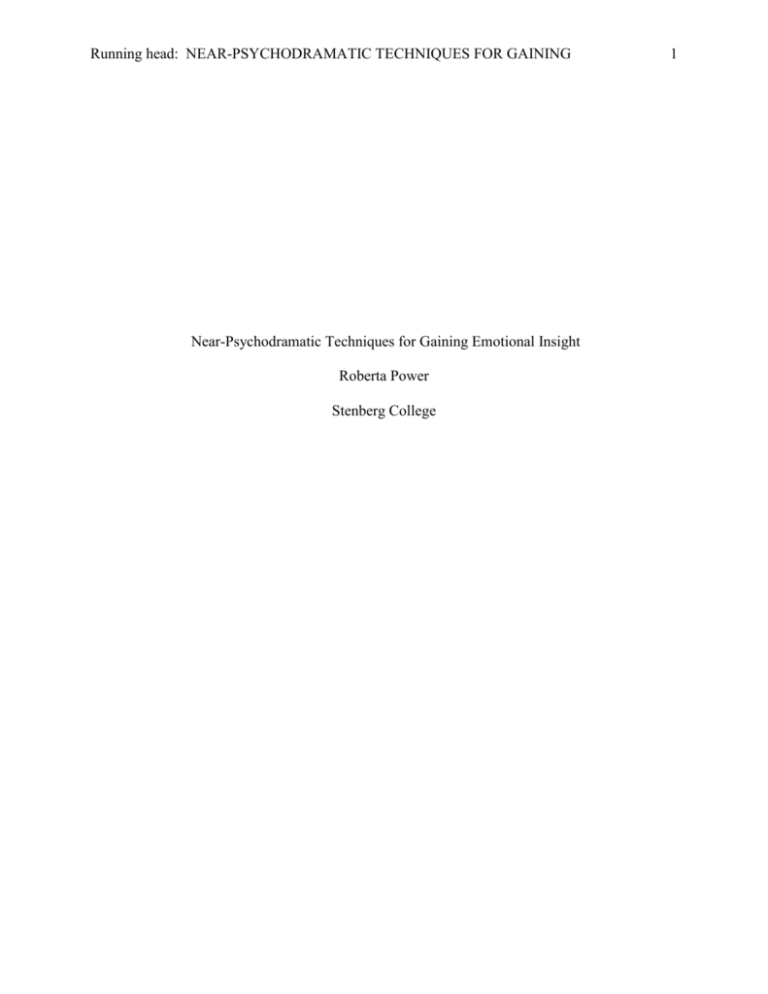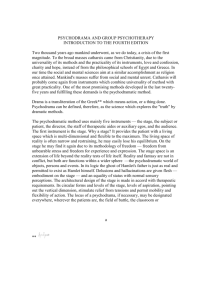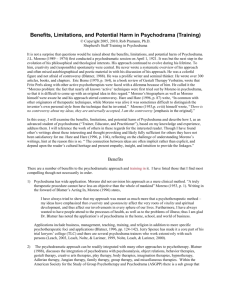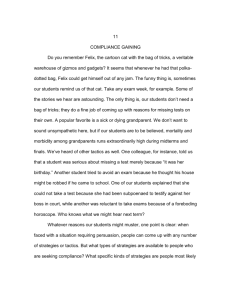Near-Psychodramatic Techniques for Gaining Emotional Insight
advertisement

Running head: NEAR-PSYCHODRAMATIC TECHNIQUES FOR GAINING Near-Psychodramatic Techniques for Gaining Emotional Insight Roberta Power Stenberg College 1 NEAR-PSYCHODRAMATIC TECHNIQUES FOR GAINING 2 Near-Psychodramatic Techniques for Gaining Emotional Insight Initially, I had no concept of what psychodrama was. To my surprise, it turned out to be much more than I had expected. The idea of reenacting old scenes from one’s life in order to heal the emotional trauma that resulted from those experiences was extraordinary to me. It was difficult to understand at first but the more I read and progressed through the course, the more I came to appreciate the value of psychodramatic therapy. This course has turned out to be one of my favorite courses as it deals with many of the issues I am sure to encounter as a psychiatric nurse. As an RPN, I will likely be encountering many clients who have experienced trauma. The near-psychodramatic techniques I have studied, such as learning about the authentic self, journaling with a photograph, and examining my social atom will help me give clients tools to work with in order to resolve, or identify, buried emotions. As well, I can continue to utilize these techniques in my own life in order to enhance my self-awareness, which I feel these exercises have done. In a paper looking at the benefits of using psychodrama as an effective tool for gaining self-awareness in nurses, the authors explained it this way: “…nurses typically face the pressure of emotions and stress, and psychodrama may help them to gain insight and allow them to be conscious of and express the underlying attitudes and feelings relevant to interpersonal situations” (Oflaz, Meric, Yuksel, & Ozcan, 2011, p. 570). As I will be using myself as a therapeutic tool as an RPN, I will need to be keenly aware of what I am bringing into the therapeutic relationship in order to help my clients feel safe and accepted. Exercise About the Authentic Self This exercise took an interesting approach to gaining self-awareness. Most times, it is easier for me to identify my negative qualities than my positive ones, and I believe this to be true for most people. I usually spend most of my thought energy on my inadequacies and areas I need NEAR-PSYCHODRAMATIC TECHNIQUES FOR GAINING 3 to improve on; it does not seem natural to think about my positive characteristics. I believe the reason for this stems from the judgmental and competitive society we are raised in, which conditions us to constantly focus on our shortcomings. This was made apparent to me by my difficulty in being able to answer the questions describing my positive qualities and talents. I needed a family member’s assistance with this exercise to help me generate ideas. It surprised me how difficult this was, and revealed to me how disconnected I am from an entire side of myself. The answers to the questions in this exercise turned out to be valuable information. Becoming aware of my positive qualities and talents will help me to be kinder to myself when my personal challenges begin to overwhelm me. I realized how important it is to have a balance in being aware of my shortcomings, but also to celebrate my good characteristics. This is, essentially, self-esteem. Dayton (2005) explains, “A healthy self-image or good self-esteem is probably one of the most important components of emotional immunity and well-being” (p. 376). As an RPN, helping clients examine their own positive qualities and talents will be important work. Many people suffering from depression and anxiety would benefit from a new perspective of themselves. A study I found researched the efficacy of psychodramatic therapy, as well as cognitive-behavioral therapy, on the negative thought-processes people suffering from depression often experience; “The psychodramatic procedures of role playing, role reversal, and mirroring should facilitate the process of examining various conflicting situations that individuals experience within the context of a group so that they can understand better the nature of negative thoughts triggered by situations and their effects on moods” (Boury, Treadwell, & Kumar, 2001, p. 21). The participants did find value in learning to identify their negative thinking patterns, and thus, learned to balance their thinking to include positive thoughts and NEAR-PSYCHODRAMATIC TECHNIQUES FOR GAINING 4 feelings about themselves, improving their overall moods. Helping clients to get in touch with their positive aspects would be a gift, as it is one way of helping people feel approval without having to seek it externally. Journaling with a Photograph This particular exercise revealed more to me than I expected. I chose a photo that gave me joy rather than sadness or anger, thus, I had some predictions about what I would write. The picture was of my ten-year-old daughter, and I proceeded to write how much I loved her and how beautiful she was. As I wrote, though, I found more feelings started to emerge that I wasn’t expecting. I began to recount how I felt at that age and there were many negative emotions attached to those memories. In this process, I realized how differently I parent my children than how I was parented. I realized this was a direct result of how I felt as a child; lonely and insecure. I understood that I was now making attempts at ensuring my children feel connected and guided by me, and that they are more than just “there”. Obviously, much more emotional awareness resulted from this exercise than I had anticipated, and it amazed me that it was so easily accessible in my mind; just below the surface waiting to be expressed. I can see how powerful this exercise could be when working with clients as an RPN. A client could use a photograph to speak to any member of his family or to himself in the past. I chose a photograph that made me happy, but still resulted in bringing up negativity. I can only imagine how powerful the emotions would be when a client used a photo that represented pain or fear. I can see how this technique might be best left to a professional in psychodramatic therapy. It would be important not to retraumatize the client, and to make sure there was adequate learning and closure brought about by the process. As Dayton (2005) cautions: “… [these techniques] are powerful in and of themselves and should be used carefully in a highly structured NEAR-PSYCHODRAMATIC TECHNIQUES FOR GAINING 5 and focused manner, and ample time should be allowed for sharing what comes up” (p.180). As a near-psychodramatic exercise, it may be useful to use with a client one-on-one to encourage journaling topics or emotional exploration, not however, with a client who has experienced severe trauma. The Social Atom Exercise Initially, this exercise did not seem as though drawing my family of origin onto paper in relation to me would prove useful; however, again this exercise surprised me in how much emotion is associated with my childhood and family. My placement on the paper was not drawn very close to my parents, and I immediately realized that I never felt close with them. Suddenly, I could sense the emotions of loneliness and, somewhat, neglect and how these feeling have been carried through to my adulthood. Looking at my social atom in this way, as brief as it was, gave me some immediate insight into some current themes happening in my life. As I had not felt bonded with my family of origin, I am still searching for that bond as I still have feelings of loneliness and lack of belonging. I can certainly see the value of this exercise in that looking back can give powerful clues to present issues. As an RPN, a technique such as this one may benefit a client by helping them understand the connection between past experiences and current problems. Many people may not be aware of how their family of origin relationships affect their current relationships, or lack of them. In a paper I found on Moreno’s social atom theory (SAT), the author summarizes Moreno’s intention in developing this theory; “Moreno intended his SAT to describe, explain, and predict how people develop and maintain long-term interpersonal relationships. Although a person’s social atom fluctuates, the basic structures and components of most social atoms are, by definition, stable over time” (Remer, 2001, p. 75). As this exercise helped me to immediately see how NEAR-PSYCHODRAMATIC TECHNIQUES FOR GAINING 6 feelings from my past were reflected in relationships I currently have, I think this would be a very effective near-psychodramatic technique to use with a client to help them gain insight into their current social atom situations. Overall, I have been very impressed with the level of learning I have experienced in this course. The near-psychodramatic techniques we have learned are not only essential to selfawareness as a nurse, but also provide tools I can use to help clients gain insight into their life’s issues. Although this course does not qualify RPN students to become psychodramatic therapists, these exercises prove that even small, self-reflective techniques can be helpful for clients. The techniques of journaling with a photograph, reflecting on one’s authentic self, and drawing out one’s social atom are user-friendly, easy to understand, and provide immediate insights. The most advantageous aspect of these exercises is that each client is in control of the process, delving as deep into their emotions as they want to go. In this way, any insight gained by the client will be more meaningful for them as opposed to being told by a therapist what their past represents (Dayton, 2005). I am looking forward to learning more about this fascinating subject. NEAR-PSYCHODRAMATIC TECHNIQUES FOR GAINING 7 References Boury, M., Treadwell, T., & Kumar, V. K. (2001, March 1). Integrating psychodrama cognitive therapy-An exploratory study. International Journal of Action Methods, 54(1), 13-37. Retrieved from http://search.ebscohost.com/login.aspx?direct=true&db=pbh&AN=7230951&site=ehostlive Dayton, T. (2005). The living stage: A step-by-step guide to psychodrama, sociometry and experiential group therapy. Deerfield, FL: Health Communications. Oflaz, F., Meric, M., Yuksel, C., & Ozcan, C. T. (2011, September 1). Psychodrama: An innovative way of improving self-awareness of nurses. Journal of Psychiatric and Mental Health Nursing, 18(7), 569-575. Retrieved from http://search.ebscohost.com/login.aspx?direct=true&db=rzh&AN=2011252376&site=eho st-live Remer, R. (2001, June 1). Social atom theory revisited. International Journal of Action Methods, 54(2), 74-83. Retrieved from http://search.ebscohost.com/login.aspx?direct=true&db=pbh&AN=8559290&site=ehostlive










